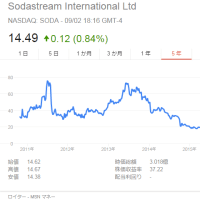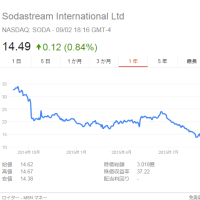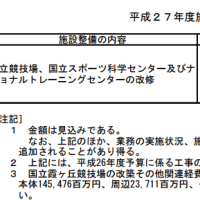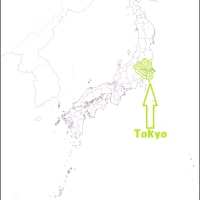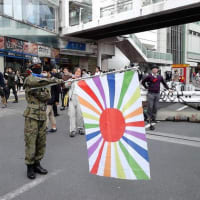今年6月、IFAW(International Fund for Animal Welfare:国際動物福祉基金)がホエールウオッチングによる経済効果に関する調査報告書(Whale Watching Worldwide)を公表していた。
つーか、ホエールウオッチングを楽しむ人達がどれだけいるのかについてろくに知らない俺(馬鹿)。
とはいえ、世界的に見たら、それなりの商売になってるっぺぇ。
それに、天下の日本でも結構これをやってる場所が存在するしな。
この辺は以下を参照。
・小笠原・ホエールウオッチングの旅6日間
(alps-enterprise.co.jp)
・ホエールウオッチング(和歌山県 那智勝浦町)
で、IFAW は過去にも同様の調査をおこなっていたっぺぇ
2001年の調査報告書概要は↓
・Whale Watching Worldwide(2001年7月?日 ecoquest.co.jp)
今年の調査報告書全文は↓
・Whale Watching Worldwide Tourism numbers, expenditures and expanding economic benefits(2009年6月20日? ifaw.org;.pdfファイル)
正直、この調査報告書を全文ネタにするとなると山ごもりしない限り不可能(馬鹿)なので、ここでは日本におけるホエールウオッチングの経済効果をネタにしてみる。
以下、IFAW の調査報告書の P.135 から、日本のホエールウオッチングに関するデータを引用する。
ただし、収入関連の金額単位は米ドル。
---- 以下引用 ----
・参加者人数
*1991年:10,992
*1994年:55,192
*1998年:102,785
*2008年:191,970
・AAGR(年間平均成長率:annual average growth rate)
*1991年:N/A
*1994年:71.2%
*1998年:16.8%
*2008年:6.4%
・業者数(Number of Operators)
*1991年:N/A
*1994年:N/A
*1998年:45
*2008年:104
・直接収入(Direct Expenditure)
*1991年:371,000
*1994年:3,384,000
*1998年:4,300,000
*2008年:7,375,076
・間接収入(Indirect Expenditures)
*1991年:4,370,000
*1994年:20,155,000
*1998年:28,684,000
*2008年:15,345,902
・合計収入(Total Expenditure)
*1991年:4,748,000
*1994年:23,539,000
*1998年:32,984,000
*2008年:22,720,978
---- 引用以上 ----
間接収入ってのは、ホエールウオッチングを行ってる場所での土産品や旅館などの収入・・・らしい
(本当は、直接収入と間接収入について厳密な定義があるけど省略)。
良くも悪くも、日本では土産品とかで金を使わない傾向にあるってのがバレバレっつー(苦笑)。
もう少し、土産品とかで金を使って欲しいものだわな。
俺の場合、それ以前の問題として旅行資金と暇が・・・(謎)。
なお、この調査報告書では、日本で「調査捕鯨」とホエールウオッチングがどのように受け止められてるかについて意味深な言及があった。
以下、IFAW の調査報告書の P.142 を長くなるが全文引用する。
---- 以下引用 ----
Local Case Study: Japan
Internationally, Japan is better known for whaling than whale watching.
Many people in non‐whaling countries are surprised to learn that Japan has the largest cetacean watching industry in Asia (by total expenditure), particularly given the controversy over its ”scientific whaling” programme.
In fact, Japan’s whale watching industry generates many times more revenue than its whale meat industry, which is also heavily subsidised by the government.
Japanese attitudes to whales, whaling and whale watching are often misunderstood by foreigners.
Japan has conservationists who are just as committed to conserving cetaceans as their counterparts overseas.
Other Japanese are determined to protect what they see as their cultural, economic and culinary heritage, in continuing to hunt and eat whales.
The vast majority of the population sits in the middle -- broadly supportive of conservation, consider themselves ‘nature’ lovers and not opposed to the idea of eating whale meat.
Many Japanese see no contradiction in going whale watching one day and another day eating whale.
Whale watching operations in Japan sometimes reflect this breadth of opinion.
Many operators emphasise conservation and strive to inform their patrons about cetaceans’ lives and the threats they face.
They provide information about whales and other ecological issues.
This is particularly the case in Eastern Hokkaido, Okinawa and Ogasawara, areas known for their clean environment and ecotourism.
In other areas, such as Shikoku, parts of Honshu and parts of Hokkaido, fishermen make some extra money by taking tourists to see whales, but there is little emphasis on conservation and little effort to develop into a sustainable tourism industry.
Parts of these communities are said to be unfriendly towards whale watching, due to perceptions that it may harm efforts to reinstate whaling in the future.
This is a shame for whale watching locally, as these areas have great potential, with some of the best large cetacean sightings in the country.
Like public opinion, the vast majority of cetacean watching in Japan is between these two extremes.
By far the largest number of cetacean watchers in Japan watch dolphins in the western bays of Kyushu.
Operators here do not seem to emphasise conservation issues or education, but they are keen to promote dolphin watching and dolphins as a lucrative symbol of the area’s tourism.
Dolphin watchers are often day‐trippers and families, who have fun watching the playful dolphins, without considering the issues that trouble the pro‐ and anti‐whaling factions.
Dolphin watching here is fun and lucrative.
This last point about cetacean watching being lucrative is important.
I recently met a Japanese butcher and discussed Japanese meat markets.
He lamented that whale tongue, his favourite cut, is so difficult to come by.
He had recently been whale watching in Victoria, Australia but could not understand why Australians would object to his selling whale, when they are quite happy to eat kangaroo.
While he has no intention of stopping eating and selling whale, he was interested to hear about the economic value of whale watching in Australia, Japan and other places.
As a small businessman, he quickly understood the implications of even limited whaling on the profits of businesses set up to watch the rare and spectacular mammals.
Convincing Japanese that whaling is morally wrong will be very difficult.
Convincing them that their whale watching industry needs support and protection might be a lot easier.
Rod Campbell:Rod lived in Japan for two years and completed his undergraduate environmental economics studies at Kyoto University.
This is his personal reflection on whaling and whale watching in Japan.
---- 引用以上 ----
そういえば、2007年に知床でホエールウオッチングをやってた観光船の目の前に捕鯨船が出現した(その後で捕鯨を行った)なんて話もあったよな。
・知床クジラ観光船 目の前で捕獲見た 捕鯨船「操業中の接近自粛を」(2007年8月21日 YOMIURI-ONLINE)
で、この件について長谷川 正人船長はこんな事を・・・。
以下、2007年8月21日分 YOMIURI-ONLINE『知床クジラ観光船~』から長谷川船長の発言を(略
---- 以下引用 ----
(中略)
海域のツチクジラ漁は20日に解禁されていた。今回の遭遇について、下道水産の下道吉一社長(54)は「捕獲中のクジラはもがき、船同士が衝突する恐れがある。操業中の接近は自粛してほしい」と話している。
一方、長谷川船長は「捕鯨砲の砲手が砲から離れるのを確認したり、捕鯨船から400~500メートルの距離を保ったりして、安全確保を図った」としている。
(以下略)
---- 引用以上 ----
日本だと捕鯨の現場を見るのはタブーってことだろうか?
つーか、ホエールウオッチングを楽しむ人達がどれだけいるのかについてろくに知らない俺(馬鹿)。
とはいえ、世界的に見たら、それなりの商売になってるっぺぇ。
それに、天下の日本でも結構これをやってる場所が存在するしな。
この辺は以下を参照。
・小笠原・ホエールウオッチングの旅6日間
(alps-enterprise.co.jp)
・ホエールウオッチング(和歌山県 那智勝浦町)
で、IFAW は過去にも同様の調査をおこなっていたっぺぇ
2001年の調査報告書概要は↓
・Whale Watching Worldwide(2001年7月?日 ecoquest.co.jp)
今年の調査報告書全文は↓
・Whale Watching Worldwide Tourism numbers, expenditures and expanding economic benefits(2009年6月20日? ifaw.org;.pdfファイル)
正直、この調査報告書を全文ネタにするとなると山ごもりしない限り不可能(馬鹿)なので、ここでは日本におけるホエールウオッチングの経済効果をネタにしてみる。
以下、IFAW の調査報告書の P.135 から、日本のホエールウオッチングに関するデータを引用する。
ただし、収入関連の金額単位は米ドル。
---- 以下引用 ----
・参加者人数
*1991年:10,992
*1994年:55,192
*1998年:102,785
*2008年:191,970
・AAGR(年間平均成長率:annual average growth rate)
*1991年:N/A
*1994年:71.2%
*1998年:16.8%
*2008年:6.4%
・業者数(Number of Operators)
*1991年:N/A
*1994年:N/A
*1998年:45
*2008年:104
・直接収入(Direct Expenditure)
*1991年:371,000
*1994年:3,384,000
*1998年:4,300,000
*2008年:7,375,076
・間接収入(Indirect Expenditures)
*1991年:4,370,000
*1994年:20,155,000
*1998年:28,684,000
*2008年:15,345,902
・合計収入(Total Expenditure)
*1991年:4,748,000
*1994年:23,539,000
*1998年:32,984,000
*2008年:22,720,978
---- 引用以上 ----
間接収入ってのは、ホエールウオッチングを行ってる場所での土産品や旅館などの収入・・・らしい
(本当は、直接収入と間接収入について厳密な定義があるけど省略)。
良くも悪くも、日本では土産品とかで金を使わない傾向にあるってのがバレバレっつー(苦笑)。
もう少し、土産品とかで金を使って欲しいものだわな。
俺の場合、それ以前の問題として旅行資金と暇が・・・(謎)。
なお、この調査報告書では、日本で「調査捕鯨」とホエールウオッチングがどのように受け止められてるかについて意味深な言及があった。
以下、IFAW の調査報告書の P.142 を長くなるが全文引用する。
---- 以下引用 ----
Local Case Study: Japan
Internationally, Japan is better known for whaling than whale watching.
Many people in non‐whaling countries are surprised to learn that Japan has the largest cetacean watching industry in Asia (by total expenditure), particularly given the controversy over its ”scientific whaling” programme.
In fact, Japan’s whale watching industry generates many times more revenue than its whale meat industry, which is also heavily subsidised by the government.
Japanese attitudes to whales, whaling and whale watching are often misunderstood by foreigners.
Japan has conservationists who are just as committed to conserving cetaceans as their counterparts overseas.
Other Japanese are determined to protect what they see as their cultural, economic and culinary heritage, in continuing to hunt and eat whales.
The vast majority of the population sits in the middle -- broadly supportive of conservation, consider themselves ‘nature’ lovers and not opposed to the idea of eating whale meat.
Many Japanese see no contradiction in going whale watching one day and another day eating whale.
Whale watching operations in Japan sometimes reflect this breadth of opinion.
Many operators emphasise conservation and strive to inform their patrons about cetaceans’ lives and the threats they face.
They provide information about whales and other ecological issues.
This is particularly the case in Eastern Hokkaido, Okinawa and Ogasawara, areas known for their clean environment and ecotourism.
In other areas, such as Shikoku, parts of Honshu and parts of Hokkaido, fishermen make some extra money by taking tourists to see whales, but there is little emphasis on conservation and little effort to develop into a sustainable tourism industry.
Parts of these communities are said to be unfriendly towards whale watching, due to perceptions that it may harm efforts to reinstate whaling in the future.
This is a shame for whale watching locally, as these areas have great potential, with some of the best large cetacean sightings in the country.
Like public opinion, the vast majority of cetacean watching in Japan is between these two extremes.
By far the largest number of cetacean watchers in Japan watch dolphins in the western bays of Kyushu.
Operators here do not seem to emphasise conservation issues or education, but they are keen to promote dolphin watching and dolphins as a lucrative symbol of the area’s tourism.
Dolphin watchers are often day‐trippers and families, who have fun watching the playful dolphins, without considering the issues that trouble the pro‐ and anti‐whaling factions.
Dolphin watching here is fun and lucrative.
This last point about cetacean watching being lucrative is important.
I recently met a Japanese butcher and discussed Japanese meat markets.
He lamented that whale tongue, his favourite cut, is so difficult to come by.
He had recently been whale watching in Victoria, Australia but could not understand why Australians would object to his selling whale, when they are quite happy to eat kangaroo.
While he has no intention of stopping eating and selling whale, he was interested to hear about the economic value of whale watching in Australia, Japan and other places.
As a small businessman, he quickly understood the implications of even limited whaling on the profits of businesses set up to watch the rare and spectacular mammals.
Convincing Japanese that whaling is morally wrong will be very difficult.
Convincing them that their whale watching industry needs support and protection might be a lot easier.
Rod Campbell:Rod lived in Japan for two years and completed his undergraduate environmental economics studies at Kyoto University.
This is his personal reflection on whaling and whale watching in Japan.
---- 引用以上 ----
そういえば、2007年に知床でホエールウオッチングをやってた観光船の目の前に捕鯨船が出現した(その後で捕鯨を行った)なんて話もあったよな。
・知床クジラ観光船 目の前で捕獲見た 捕鯨船「操業中の接近自粛を」(2007年8月21日 YOMIURI-ONLINE)
で、この件について長谷川 正人船長はこんな事を・・・。
以下、2007年8月21日分 YOMIURI-ONLINE『知床クジラ観光船~』から長谷川船長の発言を(略
---- 以下引用 ----
(中略)
海域のツチクジラ漁は20日に解禁されていた。今回の遭遇について、下道水産の下道吉一社長(54)は「捕獲中のクジラはもがき、船同士が衝突する恐れがある。操業中の接近は自粛してほしい」と話している。
一方、長谷川船長は「捕鯨砲の砲手が砲から離れるのを確認したり、捕鯨船から400~500メートルの距離を保ったりして、安全確保を図った」としている。
(以下略)
---- 引用以上 ----
日本だと捕鯨の現場を見るのはタブーってことだろうか?













